
Back flexibility: improves with Yoga practice. From a yoga perspective, the flexibility of the spine determines a person’s age more than the years they actually have.
Keeping it flexible is therefore equivalent to staying young but it is not a simple thing. Due to gravity, the intervertebral discs are compressed and this leads them to degenerate. With age, then, they tend to become less flexible and more fragile. Their wear can cause compression of the spinal nerves, causing various disorders: pain, loss of sensation or functionality of the limbs.
Furthermore, those who have a dominant side of the body with more developed muscles risk incorrectly aligning the spine and are more exposed to back pain and sciatica.
Back flexibility: the spine
The spine is the river of life. Human energy flows inside it, sending impulses to the brain and transmitting commands from the brain to the muscles and internal organs.
To the left and right of the spine there are two nerve channels, known as ida and pingala , the name hata itself refers to the movement of energy in these two channels.
Back flexibility: the Tha
Tha refers to the downward movement of energy on the right side of the spine, linked to negative energy. The upward movement on the left side is associated with health, courage, good mood, laughter. It is also related to the inspiratory phase of breathing. The downward movement in the right side is associated with discouragement, illness. It is said to be the cause of exhalation.
Let’s think about when a person is sick the fever rises, observe how the exhalation becomes visibly stronger than the inhalation. Or think about how an unhappy person sighs, while a joyful person inhales deeply as if drawing the wonders of the world towards him.
This up and down is the way the world goes.
Yoga positions and their benefits
Ustrasana
Camel Position:
- It stretches the entire front part of the body, ankles, thighs and groin
- Abdomen and chest, throat
- Stretches the hip flexors (psoas)
- Strengthens your back muscles
- Improves posture
- Stimulates the abdominal organs and neck
Salamba Sarvangasana
Position of the candle with holder:
- It relaxes the mind and helps relieve stress and mild forms of depression
- Stimulates the thyroid, prostate glands and abdominal organs
- Stretch your shoulders and neck
- Tones legs and buttocks
- Improves digestion
- It helps relieve the symptoms of menopause
- Relieves the feeling of tiredness and reduces the symptoms of insomnia
- It has a therapeutic function for asthma, infertility and sinusitis
- Halasana (Plow Pose)
- Calm the mind
- Stimulates the abdominal organs and the thyroid
- Stretches your shoulders and spine
- It helps relieve the symptoms of menopause
- Reduces stress and fatigue
- It has a therapeutic function for back pain, headache, infertility, insomnia and sinusitis
read also: Living Mindfully with Diabetes: Achieving Optimal Health